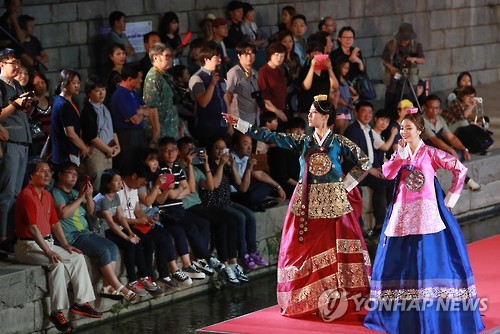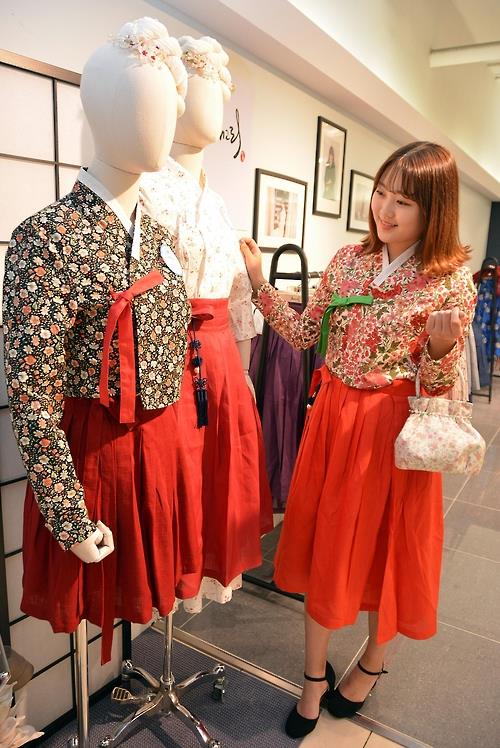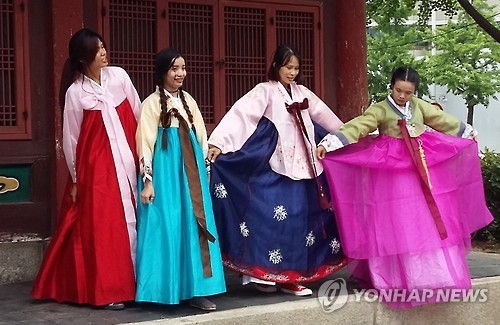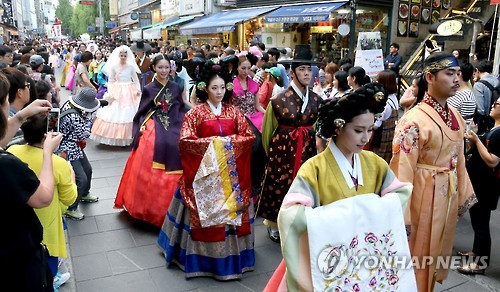- California Assembly OKs highest minimum wage in nation
- S. Korea unveils first graphic cigarette warnings
- US joins with South Korea, Japan in bid to deter North Korea
- LPGA golfer Chun In-gee finally back in action
- S. Korea won’t be top seed in final World Cup qualification round
- US men’s soccer misses 2nd straight Olympics
- US back on track in qualifying with 4-0 win over Guatemala
- High-intensity workout injuries spawn cottage industry
- CDC expands range of Zika mosquitoes into parts of Northeast
- Who knew? ‘The Walking Dead’ is helping families connect
Modern hanbok brands infiltrate mainstream retailers
SEOUL, Sept. 12 (Yonhap) — Modern versions of Korean traditional clothing, hanbok, are increasingly infiltrating local department stores and mainstream retailers, as they have become the latest cool trend among fashion-savvy youngsters, industry officials said Monday.
Many Korean women accustomed to modern garments had dismissed the dragging skirts and cropped cross-collar jackets as being uncomfortable, wearing them only for special occasions like weddings, a child’s first birthday or other big family events.

Female models walk on a stage set on Cheonggye Stream in downtown Seoul during a hanbok fashion show held on Sept. 10, 2016.
But the perception has started to change, as a growing number of young people have been sharing their experiences of going on outings to ancient palaces and traditional villages in colorful hanbok through social networking sites like Twitter and Instagram.
On the design front, emerging designers have presented fusion garments by making the women’s skirts shorter and men’s trousers slimmer, therefore more practical and easy to wear for a modern lifestyle.
While hanbok shops are mostly concentrated in traditional markets and Insadong, an art and antique street in downtown Seoul, local department stores have increasingly embraced the long-estranged traditional dress to capitalize on the latest trends.
Last month, Shinsegae Department Store opened a “Tchai Kim” store in its Gangnam branch featuring various hanbok garments by designer Kim Young-jin.

The “Tchai Kim” hanbok shop on the fifth floor of Shinsegae Department Store’s Gangnam branch is shown in this photo provided by Shinsegae.
Kim has made a splash in the local fashion scene by turning the traditional “cheollick” official male robe into a woman’s dress. Cheollik, a skirted men’s outer robe worn by government officials or noblemen going on field trips, was adapted into a women’s one-piece dress, a totally new format for the traditional female costume characterized by the skirt-jacket ensemble.
“We have opened the new store in Shinsegae Department upon its request and received positive responses from various groups of customers. Women in their 20s, 30s and 40s are our main customers and the cheollik one-piece is the most popular item,” an official at Tchai Kim told Yonhap News by phone. “I think department stores opening hanbok shops reflects that hanbok is not a short-lived fad, but an emerging new trend that can appeal to a wider customer base.”
Daegu Department Store, a local department based in the southern city of Daegu, last month opened a “chima jeogori” pop-up store. “Chima” is a full-length empire-waist airy skirt, and “jeogori” is a cropped cross-collar jacket with two long ties.

This undated photo provided by Daegu Department Store shows a woman checking out hanbok at a pop-up store in Daegu.
According to officials, the store has been frequented by female customers in their teens and 20s who want to try out different designs of modernized hanbok.
In June, Hyundai Department Store also opened a pop-up store in its Pangyo branch south of Seoul, which was a collaboration project by Leesle, a lifestyle hanbok brand, and Hite Jinro, a local distiller.
The store sold limited edition hanbok skirts worn by a retro girl character for “Chamisul Toktok,” a sparkling soju brand targeted at young female drinkers, as well as character ecobags and scarves.
Industry watchers expect the diversified retail channel to further boost the popularity of hanbok among those who appreciate the evolution of traditional heritage.

Foreign travelers show off their hanbok during their visit to a traditional village in Seoul on July 3, 2016.
According to Shinhan Card’s Trend Institute, the ratio of hanbok buyers and lenders aged below 24 jumped from 2 percent in 2013 to 6 percent in 2015. While demands for hanbok usually surge during national holidays or wedding seasons, hanbok use by 20-somethings has steadily increased throughout the year, it said.
“Hanbok is a unique material for youngsters who want to differentiate themselves from others. Wearing hanbok has become a pastime among open-minded young people who like to take pictures with foreign travelers in sightseeing places,” the institute said.
“The diversified distribution channels have also fueled the latest trend, allowing people to borrow hanbok not only offline but also online and through SNS sites.”

A traditional hanbok fashion parade trails through Insadong, an antique and art gallery street in downtown Seoul on Sept. 12, 2016.








![일본 사도광산 [서경덕 교수 제공. 재판매 및 DB 금지]](http://www.koreatimesus.com/wp-content/uploads/2024/07/PYH2024072610800050400_P4-copy-120x134.jpg)



kelly
November 27, 2017 at 4:39 PM
yes..I like the basic concepts behind Second Life but it seems incredibly outdated and when I played it was intensely non-intuitive / user friendly to an extent that made EVE look like a game for toddlers. thanks from
togel online
leticia
December 23, 2017 at 4:44 AM
wow this site is so amazing, i really really love it agen poker online indonesia
simon
December 24, 2017 at 2:44 AM
i really like your article and i love it badoqq
leticia
December 24, 2017 at 10:37 PM
domino qiu qiu